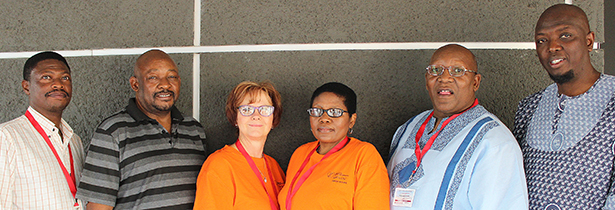
From the left are: Bahedile Letlala, Dr Elias Malete, Hannetjie du Toit, Dr Sara Motsei, Dr Edwin Mohatlane and Prof Mogomme Masoga.
The University of the Free State was proud to host the national conference of the Southern African Folklore Society which took place on 7-9 October 2015 on the Bloemfontein Campus. The focus of the conference was on how to integrate folklore studies into the 21st century.
Keynote speakers for the conference included Prof Antoinette Tidjani-Alou (Professor of French and Comparative Literature at University Abdou Moumouni), Prof Mogomme Alpheus Masoga (University of Venda), and Prof Mohlomi Moleleki (University of the Free State).
The speakers approached their subjects in great detail, tackling issues surrounding identity, social cohesion, and orality on the African context. One of the main co-ordinators of this event, Dr Elias Malete from the Department of African Languages at the UFS, highlighted one of the speaker’s topics, which focused on the importance of harnessing a collectivistic culture, as the African context does not entertain individualism. When asked about how such a conference fits into the UFS context, and where it could be applied, Malete mentioned the burning issue of the language policy review. He believes that: “The language should be inclusive, in as much as our theme says we cannot entertain individualistic approaches, but need to include everybody.” This is achieved through working with the Language Departments,” he said.
In particular, the topic presented by Prof Moleleki from the Department of African Languages, explored how the self-perception of an African, both as an integral member of his society as well as an independent individual, not only informs but also underpins his identity.
In all the topic discussed, the importance of coherence, transparency, and correctness was noted.